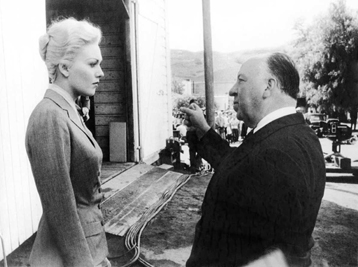Last night I finished Donald Spoto’s weighty tome, “The Dark Side of Genius: the Life of Alfred Hitchcock.” If you read through the book reviews of readers at Amazon.com, you will find several readers who really hated this book. They hate it because it is often unflattering to the great director. I have to agree, it seems that Spoto never fails to put a negative spin on the events he relates. Alfred Hitchcock is depicted as often being mean-spirited, occasionally sadistic, cold and unapproachable, and who bore grudges against those who left his employment to seek their fortunes. The unhappiest aspects that Spoto relates are Hitchcock’s obsessive infatuations with some of his leading ladies, namely Ingrid Bergman and Tippi Hedrin. However, Spoto fails to point out that such infatuations are not uncommon in men going through the so-called “midlife crisis,” a man’s version of menopause, where nature compels a man to further his bloodline while the sun still shines. Most men feel this pull in middle age, though not all of us give in to it. Hitchcock did not give in to it either; as Spoto points out, if any of his fantasies had invited him to actually touch them, he would have ran the other way, and fast. I remember my midlife crisis. I asked my wife if I could have a blonde girlfriend and a new red sports car. She said I would have to settle for a trip to McDonald’s. She’s a hard woman, that one.
No doubt Alfred Hitchcock had his difficult moments as well as his idiosyncrasies: he was a human being after all, and one who bore great pressures to produce films costing millions of dollars, films that needed to make a profit if he was to continue directing. No doubt he also suffered from the temptation of the beautiful women who surrounded him, and with whom he worked closely in the making of films. However, he sublimated his attraction to women with food (which explains his weight problem) and remained faithful to Alma.
Spoto is at his best when he describes the technical and psychological aspects of Hitchcock’s films. He makes you understand how they work and why they work. Hitchcock’s films tap into common human reservoirs of fear, longing and emotion and use brilliant symbolism that works on a subconscious level. Spoto describes the duality theme in “Strangers on a Train,” the obsessive and controlling love of Scottie in “Vertigo,” the chaos and loss of control in “The Birds.” I read Spoto’s descriptions with rapt attention, amazed at the emotional cues and triggers Hitchcock had subtly inserted in the films, things I was consciously unaware of. Hitchcock controlled all of the psychological aspects of his best films, down to the insertion of the sounds and background music, timed to most effectively provoke the desired emotional response from the audience. In his best films, Hitchcock worked on your psyche on many different levels simultaneously, working the emotional triggers that are shared by all of humanity, e.g. the fear of lost love, loneliness and death.
Spoto describes one great example of this, my personal favorite, of all of Hitchcock’s films: the moment in “Psycho” when Vera Miles climbs the stairway to the room of the malevolent mother to confront her. The old lady is sitting in a rocking chair staring out of a window with her back to Miles. Miles touches her shoulder and the rocking chair begins to slowly swing around in jerky movements until the old woman is staring Miles in the face. But the old woman is only a skeleton. This happens with the high pulsating notes of the theme music shrieking like a scream. Then Vera Miles does scream, throwing her hand up in a defensive motion and knocking the bare light bulb which hangs from a cord. The swinging light alternately bathes the skeleton face in light, then shadows, then light again, making the empty eye sockets resemble darting eyes. When I saw this scene for the first time in a theater, when in high school, I almost soiled myself.
However, I enjoyed Spoto’s description of “Vertigo” even more. It is one of the films that Spoto says are autobiographical, i.e. they contain elements from Hitchcock’s own life, fears and disappointments. Indeed, Hitch seems to use the medium of film as a means of ostracizing his own demons. Spoto says the most autobiographical are “Shadow of a Doubt” and “Vertigo.” However, let’s save that discussion for another time.
Spoto’s book contains some material that is unflattering to Hitchcock, but does nothing to upset Hitchcock’s reputation as one of the best Hollywood directors of all time. Spoto often quotes letters and other documentation to provide support for his text, but when it comes to the more controversial parts about Hitchcock, he quotes no sources or gives no references. He merely states these things to be a fact and leaves the reader to believe it or not. Take those parts with a grain of salt. I do. However, all in all, Spoto’s book is excellent, very well written and fascinating from beginning to end.







